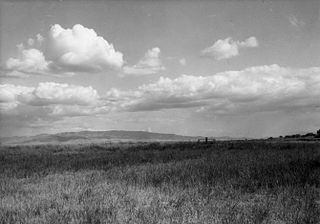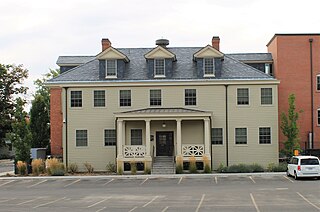
John McLoughlin, baptized Jean-Baptiste McLoughlin, was a French-Canadian, later American, Chief Factor and Superintendent of the Columbia District of the Hudson's Bay Company at Fort Vancouver from 1824 to 1845. He was later known as the "Father of Oregon" for his role in assisting the American cause in the Oregon Country. In the late 1840s, his general store in Oregon City was famous as the last stop on the Oregon Trail.

The Oregon Trail was a 2,170-mile (3,490 km) east–west, large-wheeled wagon route and emigrant trail in the United States that connected the Missouri River to valleys in Oregon Territory. The eastern part of the Oregon Trail crossed what is now the states of Kansas, Nebraska, and Wyoming. The western half crossed the current states of Idaho and Oregon.

Fort Vancouver was a 19th-century fur trading post built in the winter of 1824–1825. It was the headquarters of the Hudson's Bay Company's Columbia Department, located in the Pacific Northwest. Named for Captain George Vancouver, the fort was located on the northern bank of the Columbia River in present-day Vancouver, Washington. The fort was a major center of the regional fur trading. Every year trade goods and supplies from London arrived either via ships sailing to the Pacific Ocean or overland from Hudson Bay via the York Factory Express. Supplies and trade goods were exchanged with a plethora of Indigenous cultures for fur pelts. Furs from Fort Vancouver were often shipped to the Chinese port of Guangzhou where they were traded for Chinese manufactured goods for sale in the United Kingdom. At its pinnacle, Fort Vancouver watched over 34 outposts, 24 ports, six ships, and 600 employees. Today, a full-scale replica of the fort, with internal buildings, has been constructed and is open to the public as Fort Vancouver National Historic Site.

Oregon Country was a large region of the Pacific Northwest of North America that was subject to a long dispute between the United Kingdom and the United States in the early 19th century. The area, which had been demarcated by the Treaty of 1818, consisted of the land north of 42° N latitude, south of 54°40′ N latitude, and west of the Rocky Mountains down to the Pacific Ocean and east to the Continental Divide. Article III of the 1818 treaty gave joint control to both nations for ten years, allowed land to be claimed, and guaranteed free navigation to all mercantile trade. However, both countries disputed the terms of the international treaty. Oregon Country was the American name, while the British used Columbia District for the region.

Fort Hall was a fort in the Western United States that was built in 1834 as a fur trading post by Nathaniel Jarvis Wyeth. It was located on the Snake River in the eastern Oregon Country, now part of present-day Bannock County in southeastern Idaho. Wyeth was an inventor and businessman from Boston, Massachusetts, who also founded a post at Fort William, in present-day Portland, Oregon, as part of a plan for a new trading and fisheries company. In 1837, unable to compete with the powerful British Hudson's Bay Company, based at Fort Vancouver, Wyeth sold both posts to it. Great Britain and the United States both operated in the Oregon Country in these years.

Fort Astoria was the primary fur trading post of John Jacob Astor's Pacific Fur Company (PFC). A maritime contingent of PFC staff was sent on board the Tonquin, while another party traveled overland from St. Louis. This land based group later became known as the Astor Expedition. Built at the entrance of the Columbia River in 1811, Fort Astoria was the first American-owned settlement on the Pacific coast of North America.

The Columbia District was a fur-trading district in the Pacific Northwest region of North America, in both the United States and British North America in the 19th century. Much of its territory overlapped with the temporarily jointly occupied and disputed Oregon Country. It was explored by the North West Company between 1793 and 1811 and established as an operating fur-trading district around 1810. The North West Company was absorbed into the Hudson's Bay Company (HBC) in 1821, under which the Columbia District became known as the Columbia Department. It was considered part of British North America and later became the brief first Colony of British Columbia (1858–1866) with the subsequent merger with the Colony of Vancouver Island (1849–1866) to form a larger second short-lived Colony of British Columbia (1866–1871). After protracted negotiations with British and Canadian authorities, the newly reorganized Province of British Columbia joined in 1871 with the new Canadian confederation of 1867 further east, as the western-most province of the now trans-continental Dominion of Canada. The Oregon Treaty of June 1846, signed in Washington, D.C., by the United States and the United Kingdom, marked the effective end of the old Hudson's Bay Company's jurisdiction of the former western Columbia District / Department on the Pacific coast, although the HBC still continues a mercantile commercial business into the 21st century.

Fort Boise is either of two different locations in the Western United States, both in southwestern Idaho. The first was a Hudson's Bay Company (HBC) trading post near the Snake River on what is now the Oregon border, dating from the era when Idaho was included in the British fur company's Columbia District. After several rebuilds, the fort was ultimately abandoned in 1854, after it had become part of United States territory following settlement in 1846 of the northern boundary dispute.

Fort Okanogan was founded in 1811 on the confluence of the Okanogan and Columbia Rivers as a fur trade outpost. Originally built for John Jacob Astor’s Pacific Fur Company, it was the first American-owned settlement within Washington state, located in what is now Okanogan County. The North West Company, the PFC's primary competitor, purchased its assets and posts in 1813. In 1821 the North West Company was merged into Hudson's Bay Company, which took over operation of Fort Okanogan as part of its Columbia District. The fort was an important stop on the York Factory Express trade route to London via Hudson Bay.

Oregon pioneer history (1806–1890) is the period in the history of Oregon Country and Oregon Territory, in the present day state of Oregon and Northwestern United States.

Fort William was a fur trading outpost built in 1834 by the American Nathaniel Jarvis Wyeth, a Boston merchant, backed by American investors. It was located on the Columbia River on Wappatoo Island near the future Portland, Oregon. After a few years, in 1837 Wyeth sold the post to the British Hudson's Bay Company, which had much more power in the region from its base at Fort Vancouver on the north side of the Columbia River near Fort William.
Joseph Gervais was a French-Canadian, later American, pioneer settler and trapper in the Pacific Northwest. He is the namesake for the town of Gervais, Oregon.

French Prairie is located in Marion County, Oregon, United States, in the Willamette Valley between the Willamette River and the Pudding River, north of Salem. It was named for some of the earliest settlers of that part of the Oregon Country, French Canadian/Métis people who were mostly former employees of the Hudson's Bay Company. "French Prairie" naming was first captured in writing in the early 1850s by a French Consul to California visiting Oregon. Pierre Charles Fournier de Saint-Amant referred to the area as "les prairies françaises". French Prairie is also known as an early Métis settlement in the Pacific Northwest history.

Étienne Lucier, né Lussier, was a French-Canadian fur trader active primarily in the Pacific Northwest. He was hired by John Jacob Astor's Pacific Fur Company and sent to the region to help establish Fort Astoria. Later he became a settler in the Willamette Valley. Lucier attended the Champoeg Meetings and was one of few French-Canadians or "Canadiens" to vote for the Provisional Government of Oregon, an American and Canadian civil authority for the valley. He is credited with becoming the first European descendant farmer within the modern state of Oregon.
Pierre Belleque or Pierre Billique was a French Canadian fur trader in the British-claimed Columbia District, which was also known as the Oregon Country and also claimed by the United States. He settled on the French Prairie in what is now the state of Oregon where in 1843 he participated in the Champoeg Meetings. Pierre was elected one of three Constables. He voted affirmative for the measure to form a provisional government at the May 2, 1843 meeting. That measure passed and led to the creation of the Provisional Government of Oregon.

The York Factory Express, usually called "the Express" and also the Columbia Express and the Communication, was a 19th-century fur brigade operated by the Hudson's Bay Company (HBC). Roughly 4,200 kilometres (2,600 mi) in length, it was the main overland connection between HBC headquarters at York Factory and the principal depot of the Columbia Department, Fort Vancouver.
Thomas McKay was an Anglo-Métis Canadian fur trader who worked mainly in the Pacific Northwest for the Pacific Fur Company (PFC), the North West Company (NWC), and the Hudson's Bay Company (HBC). He was a fur brigade leader and explorer of the Columbia District and later became a U.S. citizen and an early settler of Oregon.
Michel Laframboise was a French Canadian fur trader in the Oregon Country who settled on the French Prairie in the modern U.S. state of Oregon. A native of Varennes, Quebec, he worked for the Pacific Fur Company, the North West Company, and the Hudson's Bay Company before he later became a farmer and ferry operator. In 1843 he participated in the Champoeg Meetings. Though he voted against the measure to form a provisional government, the measure passed and led to the creation of the Provisional Government of Oregon.
Fur trading on the Assiniboine River and the general area west of Lake Winnipeg, in what is now Manitoba, Canada, began as early as 1731.
The Wallace House, Wallace Post or Calapooya Fort, was a fur trading station located in the French Prairie of the Willamette Valley. Opened by the Pacific Fur Company (PFC) in 1812, it was an important source of beaver pelts and venison. The possibility of either the Royal Navy or North West Company (NWC) competitors attacking Fort Astoria during the War of 1812, motivated the PFC management to sell its assets to the NWC in late 1813. Wallace House was utilized by the NWC until 1814, when they abandoned it in favor of the nearby Willamette Trading Post. The station is now located in Keizer, Oregon.














